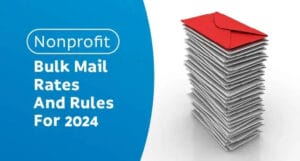How direct mail strategy fits your audience?
Before even planning your next direct mail campaign, you need to consider what direct mail strategy to choose, and how different mailing strategies fit your audience.
Saturation mailing
If you are running a small business and you want to reach potential customers in your immediate area, you may benefit the most from saturation mailing.
The most important benefit of a saturation mailing is that you’ll reach every potential customer in your target area. Rather than creating a list of targets, you would instead target a specific mail route, a neighborhood, a zip code or a district. But to qualify for maximum saturation mail discounted postage rates, you need to follow 90/75 rule. That means that you must mail to at least 90% of all residential addresses OR 75% of all business and residential addresses combined in a given carrier route if you want to qualify for the lowest saturation postage rates.
Saturation mailing allows you to do some targeting. You can remove from the list of households along a particular carrier route: all business addresses, PO boxes or some residential addresses, like seasonal addresses, apartments or drop addresses. And you can add the median demographics like age, income, and number of children, but only figures in the middle of a data set. If you want to reach people that have an exact age, for example, seniors, or families that have pets you need to go with the targeted mailing.
Saturation is used mainly to boost brand recognition, increase walk-in traffic, and promote local offers. But it doesn’t offer extensive targeting, or personalization, what results in a lower response rate of only 1-3%.
Your investment: The increased amount of mail you send, often qualifies you for bulk pricing. This is why you want to choose a low-cost format such as postcards or flyers, anything that’s cheap and efficient to produce.
Restaurants, dry cleaners, and home services are a few types of businesses that will benefit the most from saturation mailing. Everyone has to eat and clean their homes, so the potential interest should be higher than in the niche markets. A coupon or a limited time offer is included with this type of mailing to induce a more immediate response.
Targeted Mailing
Unlike general businesses that target the masses, niche businesses aim for more defined customers. If you are running a small niche business you’ll get better results with targeted mailing, which looks exclusively for specific individuals that fit your market.
This mailing strategy allows you to filter prospects by age, gender, income, and family demographics. However, it’s not limited to a specific geographical area, so you can send mailing anywhere in the world.
Also, by carefully choosing your targets, the mailing will result in less paper waste than a saturation mailing.
At the same time, targeted mail is targeted to the preferences and needs of your customers. When sending a mail piece you want to focus on relevance. Relevance leads to bigger engagement, which results in a higher response.
That’s why the main advantage of the targeted mailing strategy is segmentation. You can identify a specific category of prospects with clear demographics and buying preferences. Then, you send a customized mail piece with a relevant offer to all the prospects who fall into that category. This way, you can send several batch mailings to specific market segments.
Another benefit is that you can add personalization, that means you can place the names of your prospects and precise directions to your nearest store in the individual messages. That will definitely increase your response rate, due to the personal engagement of your customers with the mailer.
Your investment: you can invest more in the mail itself with targeted mail. These consumers fit your demographics, so you can send them a more relevant offer and expect a higher conversion rate than with saturation mailing.
Targeted mailing usually requires at least 200 pieces to be sorted and prepared according to the regulations of the USPS. So, you can send small quantities only to the prospects that are most likely to buy.
For example, niche businesses like jewelers or sporting goods stores have a unique customer base. They need to address specific demographics like the fitter, younger individuals, with certain lifestyles and incomes.
Otherwise, the less impulsive the purchase is the more you have to consider a campaign with multiple mailings rather than a one-shot mailing.
The best way to decide which strategy to use for your direct mail campaign is to know your product and thoroughly research your customers. The more you know about your audience, and how your offer can help them, the more successful your mailing campaigns will be.



